Water fire extinguishing: classification, design, installation rules. Sprinkler and deluge fire extinguishing
From the very beginning of human society, the problem of water fire extinguishing has been relevant. The first mentions of installations for extinguishing fires are present in the ancient Greek chronicles. And the first water-lifting pump was invented by the Greek scientist Ctesibius in the second century BC. Such installations are mentioned in the works of Archimedes, Pythagoras, in the scientific treatises of Heron of Alexandria, the famous architect Rome Vitruvius. Piston pump, described by the latter and until now has practically not changed in design.
History of origin
The surge of inventions related to the design of automated devices for extinguishing fires occurred at the end of the 17th century - the beginning of the 18th century. Then the installations began to be equipped with explosive devices, which were triggered at the right time and sprayed a substance from special vessels to extinguish the fire. These were barrel-shaped vessels, their appearance is associated with the reign of Peter I. At the same time, the development of fire extinguishing devices was carried out in England and Germany.
The emergence of a water fire extinguishing installation, which has become the prototype of the modern one, is associated with the work of the Russian officer - researcher K.D. Frolov. The engine in such a system was a water-filling wheel, which drives a crank mechanism connected to the pistons of the pumps that supplied water to the distribution pipe. but practical application this installation did not receive.
The first use of a sprinkler-like sprinkler in an installation was made in 1864 by the English scientist Stuart Harrison. Over the next 15 years, the design of the sprinkler underwent a number of changes that improved the original version, and the release of fire extinguishing systems was on the conveyor.
Modern systems
Today, water-based fire extinguishing is one of the most economical fire fighting systems. The low cost of the installation does not affect the reliability of the system at all. The ease of maintenance of the automatic water fire extinguishing system allows installation in a short time.
When carrying out the installation, such chemical elements that do not react with water. In addition, they are not affected by high temperatures, and do not lose their performance when exposed to them. it optimal settings intended for work in conditions increased danger... An additional advantage for water fire extinguishing installations is their long service life without repair work.
A positive feature of water fire extinguishing installations, regardless of what type of spraying they are - sprinkler or deluge, is that they spray water that forms a fog. This atomization immediately lowers the room temperature, stopping the combustion process. At the same time, water does not completely flood the premises, which significantly reduces property losses.
Sprinkler
Used for local fire extinguishing. They are also indispensable for cooling indoor structures. They are most often used in places where the room temperature is expected to rise in the event of a developing fire. These installations involve irrigation of the area with a one-time creation of curtains. This is especially used on the theater stage, on windows, doors.
When extinguishing a fire in large areas, the sprinkler network is divided into several sections, each of which is equipped with an individual control and signal valve. The installation operates in such a way that immediately when water comes in, it is automatically supplied by the water feeder. Then, using the control signal valve, the fire pumps are turned on, which provide the water necessary to extinguish the fire. Sprinkler sprinklers of water fire extinguishing installations are closed, they are opened when the temperature indicators in the room rise to a certain level.
There are the following types of sprinkler systems:
- water-filled;
- air-filled.
Water-filled sprinkler systems are pipelines filled with pressurized water.
Their main positive characteristic is considered to be close proximity fire extinguishing composition, whether it be water or a foam solution, from the source of the fire. This allows you to instantly react to fire. When using a water-filled sprinkler system, fire extinguishing is localized and carried out only at the fire site.
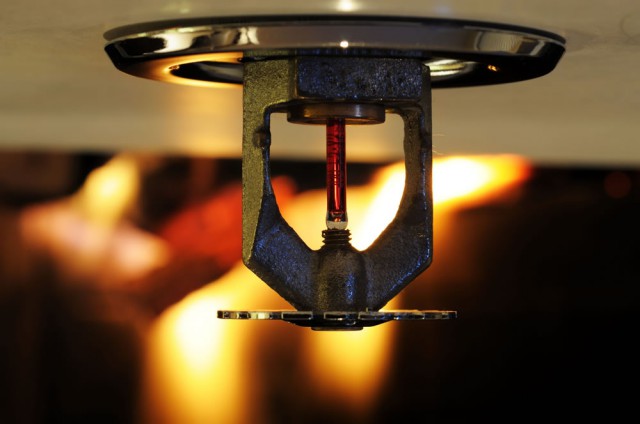 temperature regime can reach fifty degrees below zero. The reason for this limitation is that at lower temperatures, water simply freezes, and pipes and sprinklers, respectively, fail. Given this factor, the most common places for using water-filled sprinkler systems are storage and industrial premises with a heating system, offices and retail space, administrative complexes and residential buildings, hotels, theaters, cottages, saunas.
temperature regime can reach fifty degrees below zero. The reason for this limitation is that at lower temperatures, water simply freezes, and pipes and sprinklers, respectively, fail. Given this factor, the most common places for using water-filled sprinkler systems are storage and industrial premises with a heating system, offices and retail space, administrative complexes and residential buildings, hotels, theaters, cottages, saunas.
Air-filled sprinkler systems are usually installed in unheated facilities that tend to freeze. Hallmark from the previous installation is filling the pipes with nitrogen or air.
Deluge
They operate with the help of special irrigation heads, which are openly installed on the system pipelines. These pipelines are designed for fire fighting with water or foam. First of all, they are designed to create water (deluge) curtains that cut off the room in which the fire occurred from other rooms in the building.
The main task of such systems is to prevent the spread of fire across the territory. Most often, such systems are used in enterprises with an increased level of fire hazard, for example, chemical and cellulose production, paint and varnish enterprises, objects with subzero temperatures. Use with sub-zero temperatures due primarily to the lack of water in the system. It begins to be fed into the water supply, only after special signal... If the system is deactivated, then, accordingly, there is no water in the pipeline.
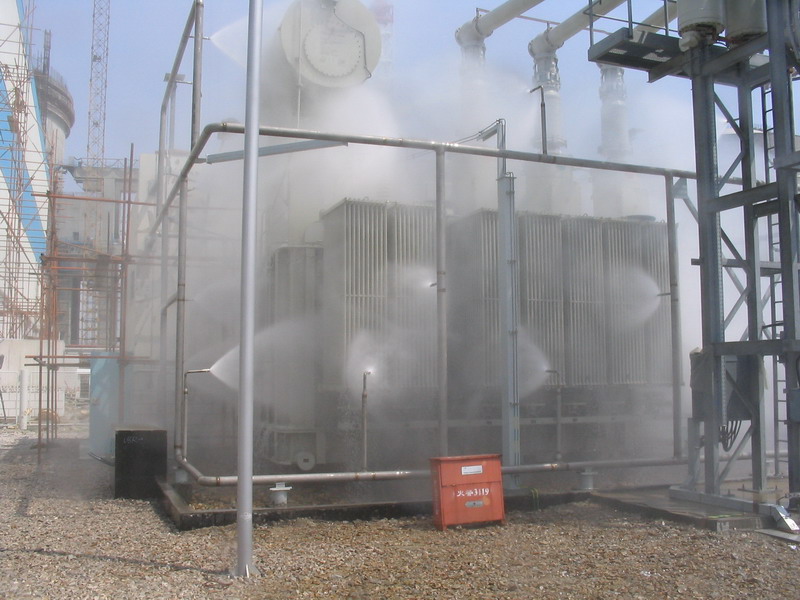
Testing a deluge fire extinguishing system
Water mist systems
More and more recently, fire extinguishing systems are used with the help of water mist... Besides that modular systems installations are completely autonomous, and do not need electricity and additional water tanks, they leave minimal consequences of fire extinguishing. These installations are a completely new technological solution, as a result of which water is supplied under great pressure, which provides the formation of water dust with a water particle size of about 100 microns.
A clear advantage in the use of such systems is the reduction in damage from the use of a fire extinguishing agent with a larger droplet size, such as in sprinkler and deluge installations. Also, the cost of purchasing water reservoirs is significantly reduced. Protected objects do not require sectioning, as in the case of using volumetric extinguishing installations.
With the help, a fine mist is formed, which quickly spreads throughout the room and at the same time does not reduce the amount of oxygen contained in the room.
When using fire extinguishing installations of this type, the fact of using a small amount of water with high fire extinguishing efficiency is also important.
This result is achieved due to the high heat capacity of water fog and a large area covered with drops. As a result, the temperature in the ignition zone drops sharply and the chemical reaction of the combustion process stops completely. These components make it possible to safely evacuate people working in the building and create optimal conditions for the work of specialists trained personnel who are equipped special means for extinguishing a fire.
Many of our Customers ask themselves this question: "What kind of fire extinguishing system to install at their facility, powder or water?" Let's dwell on each of them in more detail.
Powder automatic fire extinguishing system.
Performs extinguishing of all classes of fire by creating a certain extinguishing environment in the protected room. It is most often used in volumetric fire extinguishing, this is when extinguishing occurs in a confined space in order to create such a concentration of powder at which the fire is extinguished. In case of volumetric fire extinguishing, it is necessary to start all modules located in the protected area at the same time.
There is also local fire extinguishing, when extinguishing occurs in a specific place where a fire source is found. This method of extinguishing is the most affordable, but it may turn out to be ineffective.
According to the requirements of the norms, for the system to be automatic, it must work without any participation of people. For these purposes, an automatic fire alarm is used with all kinds of fire detectors: heat, smoke, flame, IR and UV radiation, aspiration, etc. But most often they use smoke detectors, which reacts to the primary sign of a fire - smoke, which gives the system a high inertia of detecting and extinguishing a fire.
Water fire extinguishing system.
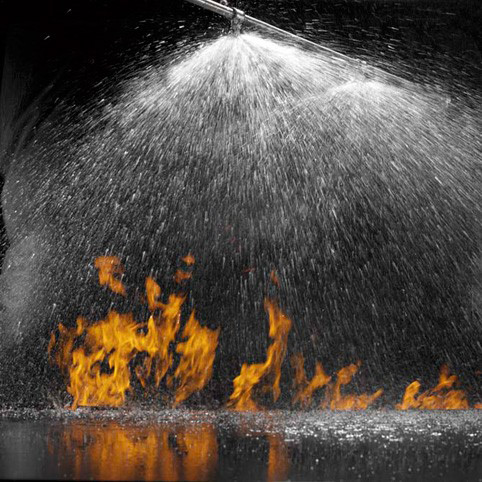 It uses ordinary water to extinguish a fire, both from the systems of the general water supply system, and from underground wells with the necessary reserve. Water fire extinguishing systems are most often used sprinkler (local) type, this is when the detection and extinguishing of a fire occurs using a special device - a sprinkler, whose design combines a shut-off device that collapses at a certain temperature and a sprinkler that sprays water over a certain area (from 9 up to 12 sq.m.). To extinguish in this area, a fire extinguishing pumping station is required, which must contain: a working pump, a backup pump, a jockey pump and a hydraulic accumulator to protect against water hammer. Sprinklers are installed on the distribution pipeline from pumping station, evenly over the entire area of the protected premises with a certain step. The main principle extinguishing a fire in a water fire extinguishing system is a cooling of the combustion center.
It uses ordinary water to extinguish a fire, both from the systems of the general water supply system, and from underground wells with the necessary reserve. Water fire extinguishing systems are most often used sprinkler (local) type, this is when the detection and extinguishing of a fire occurs using a special device - a sprinkler, whose design combines a shut-off device that collapses at a certain temperature and a sprinkler that sprays water over a certain area (from 9 up to 12 sq.m.). To extinguish in this area, a fire extinguishing pumping station is required, which must contain: a working pump, a backup pump, a jockey pump and a hydraulic accumulator to protect against water hammer. Sprinklers are installed on the distribution pipeline from pumping station, evenly over the entire area of the protected premises with a certain step. The main principle extinguishing a fire in a water fire extinguishing system is a cooling of the combustion center.
Fire extinguishing system price.
This parameter has become decisive when choosing an automatic fire extinguishing system. Let's take two buildings for example:
1 warehouse building or for industrial purposes 5,000 square meters, category B2, 12 m high;
2 warehouse or industrial building of 1000 sq.m., category B2, 6 m high;
and summarize the installation values in table 1 and table 2.
Table 1. Building of 5000 sq.m. with a ceiling height of 12 m, 60,000 cubic meters.
|
System type |
Total, rub. |
Installation cost |
|||
|
Water fire extinguishing(sprinkler) |
(including the pumping station) |
Table 2. Building 1000 sq.m. with a ceiling height of 6 m, 6,000 cubic meters.
|
System type |
Cost of equipment and materials, rub. |
Required stock of modules, rub. |
Total, rub. |
Installation cost |
The total cost of the installation, rub. |
|
Powder |
|||||
|
Water (sprinkler) |
(including the pumping station) |
* When calculating the water fire extinguishing system, we assumed that water is present at the facility in sufficient quantities. If water supply requires the construction of wells and reservoirs, then the cost of water fire extinguishing will be much higher.
Conclusion on the cost of installing a fire extinguishing system.
And so what conclusion can be drawn from the calculations? On small objects up to 2000 sq.m. and with a volume of up to 12,000 cubic meters, the cost of installing a powder fire extinguishing system is lower than a water one, but when the parameters of the protected area and volume increase, the cost of a water fire extinguishing system will decrease.
The cost of operating a fire extinguishing system.
We consider this parameter to be important, due to the fact that the substance (powder) used in powder fire extinguishing has a shelf life of 5 years, i.e. after 5 years it is necessary to dismantle all modules powder fire extinguishing, take it to the manufacturer to replace the powder, and then re-install and adjust the system. The cost of such a procedure can be up to 50% of the initial installation cost. The water fire extinguishing system does not have such a feature.
Pros and cons of fire extinguishing systems.
Of the advantages of powder fire extinguishing:
High response time, because reacts to the primary sign of fire (smoke);
- the cost of a powder fire extinguishing installation is lower than the cost of a water extinguishing system at facilities where there is no water supply and with a volume of less than 12,000 cubic meters.
Of the minuses of powder fire extinguishing:
The service life of the fire extinguishing powder is only 5 years;
Susceptible to false positives due to power surges;
High risk of malfunction. 50% consists of communication and automation wires, breaks are possible, failure of automation;
Aggressive properties of fire extinguishing powder, there are alkaline chemical elements in the powder, which can spoil the stored goods and electronic components in the event of a false alarm;
Extinguishing is one-time, i.e. if, in the case of starting a powder fire extinguishing, the fire is not extinguished, then the system does not give a second chance, in contrast to the water fire extinguishing system;
The high cost of operating the system;
Requires 100% supply of powder modules, the largest zone;
Hinder orientation and breathing of people after triggering;
Does not preclude the installation of an internal fire-fighting water supply(ERW), in contrast to water fire extinguishing, where the ERW system can be combined, which means saving on pipes, pumps, automation, etc.
Of the advantages of water fire extinguishing:
Low cost of extinguishing agent;
Low cost of ownership;
Fire extinguishing area, not volume;
High fire extinguishing ability of water;
Possibility of connection from mobile fire fighting equipment;
Possibility of combining with an internal fire-fighting water supply system;
Cooling load-bearing structures in case of fire.
Of the minuses of water fire extinguishing:
The need for guaranteed water supply;
The response time is lower than that of an automatic powder fire extinguishing system;
Water conducts electricity, electrical shock protection is required.
Water fire extinguishing system includes pumping units, distribution pipelines with sprinklers, incentive systems, control units, shut-off and shut-off-control and protective fittings (gate valves, valves, check valves), containers (reservoirs and accumulators), dispensers, compressor, annunciators, electrical equipment (monitoring and control); technical means of fire detection.
Automatic fire extinguishing systems can be divided into two main types:
![]()
Installation of pressure boosting "SmartStation" for cold water combined with ERW
1) Sprinkler automatic fire extinguishing system, in which the sprinkler (sprinkler) is installed in a pipeline system filled with water or low expansion foam (in rooms with temperatures above 5 ° C) or air (in rooms with temperatures below 5 ° C), and constantly under pressure.
There are options for the combined, water-air sprinkler ASPT, where the supply pipeline is always filled with water, and the distribution and supply pipeline, depending on the season, can be filled with water or air. Each sprinkler is closed with a special flask (thermal lock), which is designed for depressurization at a certain temperature - from 57 to 343 ° С, depending on the needs of the ASPT installation, while sensitive flasks (57 and 68 ° С) should operate within no more than 5 minutes (and ideally - 2-3 minutes), and high-temperature - within 10 minutes.
The principle of operation of the sprinkler fire extinguishing system such: after depressurization of the sprinkler, the pressure in the pipeline drops, opening the valve in the control unit, and the water rushes to the detector, which records the operation and gives a command signal to turn on the pump. Sprinkler ASPT are designed for local detection and extinguishing of fires with the inclusion of counter fire alarm, fire warning systems, smoke protection, evacuation control and issuance of information about the place of fire.
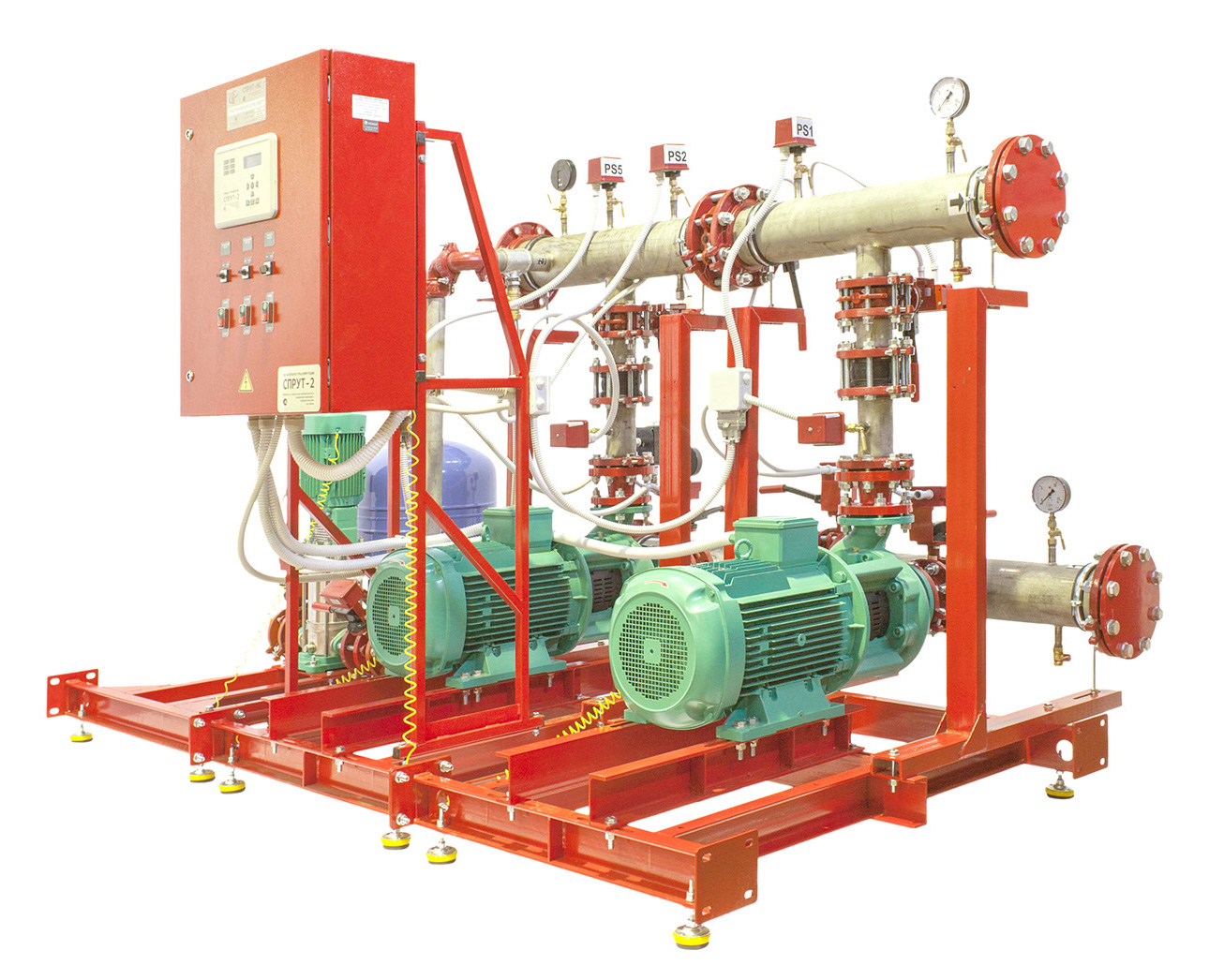
Monoblock automatic pumping units fire extinguishing "Sprut-NS"
2) Deluge automatic fire extinguishing system, is used, as a rule, to protect premises with an increased fire hazard, when the effectiveness of fire extinguishing can be achieved only with simultaneous irrigation of the entire protected area. Also deluge fire extinguishing installations used for irrigation vertical surfaces(fire curtains in theaters, technological apparatus, tanks with oil products, etc.) and the creation of water curtains (protection of openings or around any apparatus).
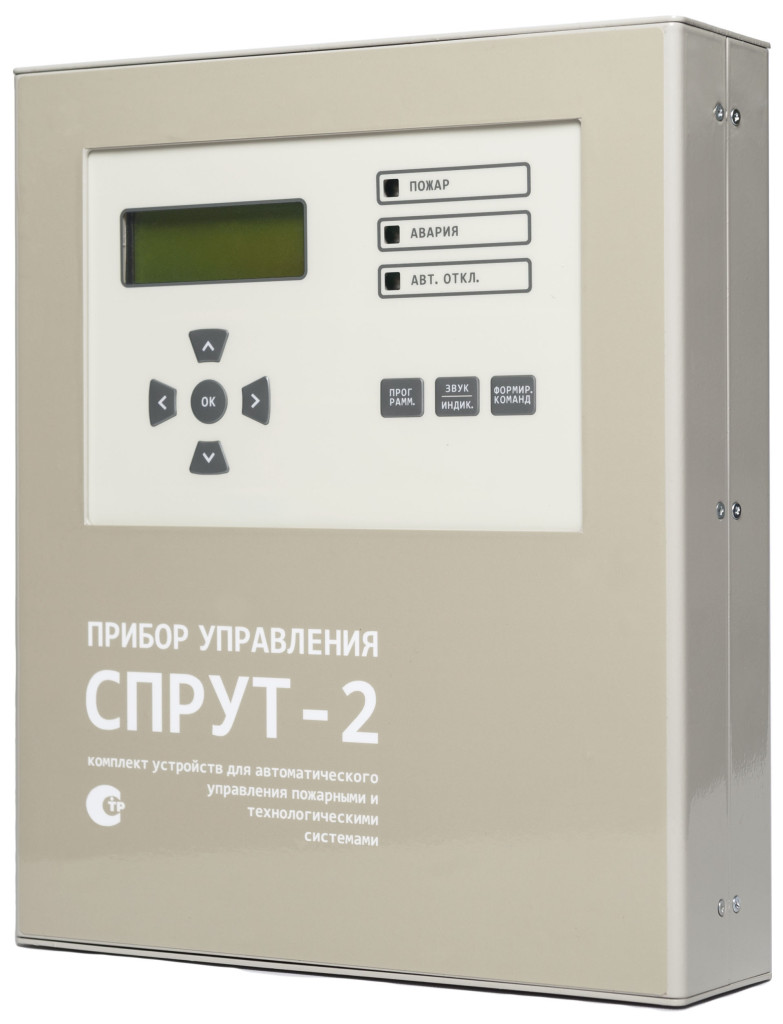
Control device
The main unit of the automatic water fire extinguishing system is, which consists of pumping units(main fire pump + standby, jockey pump) required shut-off valves, as well as a control cabinet for the installation.
Also, objects can be used in cold water supply systems combined with an internal fire-fighting water supply system.
As the main control is applied, which provides control required sensors(electro-contact pressure gauges, flow sensors), signal circuits of electric valves and starting devices, and also ensures the start of the water fire extinguishing system under several conditions: a drop in water pressure in the system, triggering of the start button, remote control commands (when operating as part of the system), etc. .d.
Water fire extinguishing scheme
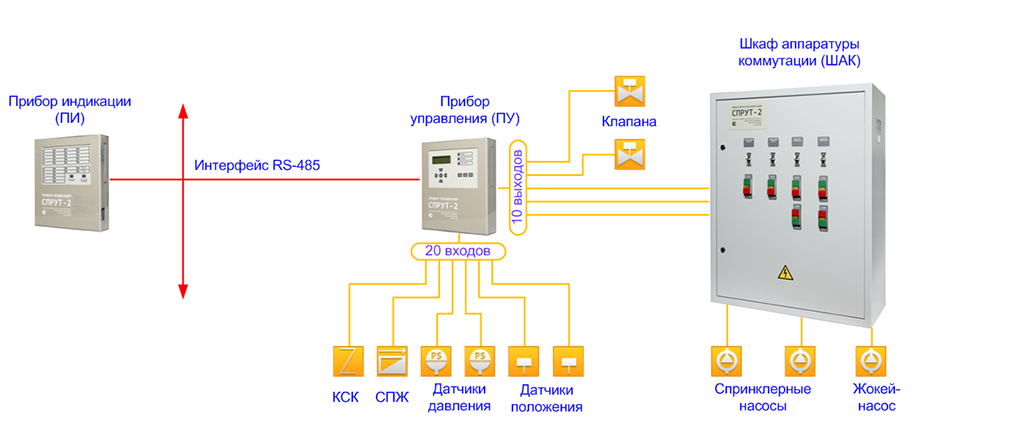
Fire-fighting water supply scheme
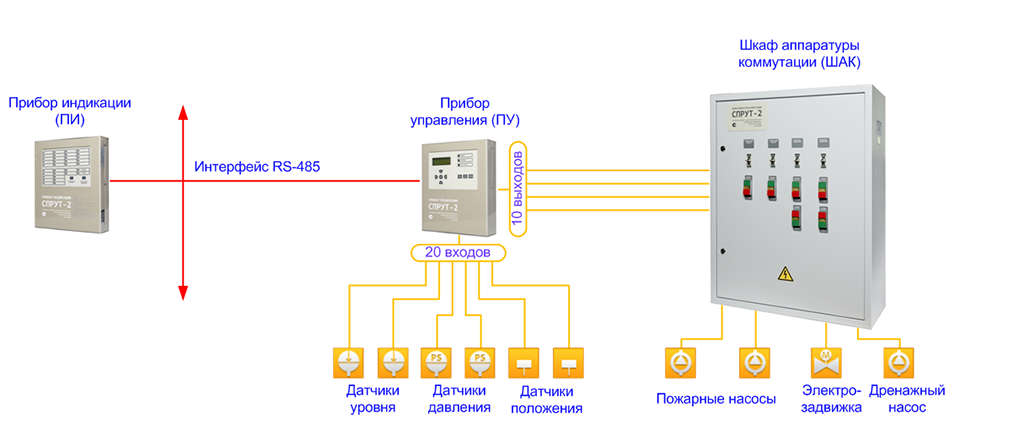
Everyone understands what constitutes the safety of any object. First of all, it is modern, technical equipment, which is guaranteed to help you cope with the arisen, emergency... But even with large, financial costs for good equipment can not be achieved maximum effect... Only thanks to human factor you can usefully realize the possibilities of protection installed system... Moreover, this applies to both the persons producing the installation and the specialists who daily monitor its work at the dispatching console. In this case, we will talk about water fire extinguishing.
If you are looking for a system that can insure you against almost any type of fire, then, of course, opt for water fire extinguishing, the equipment of which can be purchased from our specialized company. The overwhelming majority of enterprises and technical facilities are protected by this type. The only exceptions are some types of production, where there is a risk of burning flammable liquid media and the presence of low, external temperatures. It is also strictly forbidden to use a water fire extinguishing system in production with burning equipment that is not de-energized from the central voltage. In all other cases SNIP is beyond competition.
Advantages of water based fire extinguishing
What are the objective advantages of using this system? There are a lot of them and we will name the main ones:
- excellent economy, allowing to carry minimum costs... First of all, this concerns the resource itself - water. If necessary, such an installation can, without much difficulty, be disassembled, and then transported to a new location. Dismantling and installation is done pretty quickly;
- versatility in which given type fire extinguishing systems can be installed on almost any type of facility. Due to the ability to extinguish the overwhelming number of categories of fires, it has become widespread;
- reusable. To bring the water fire extinguishing system into the active readiness phase, it takes about 3 hours (depending on the design features of the module, the time may vary slightly);
- wide variation of operation. This definition hides the ability of the system to operate according to a local or general scenario at the facility. Thanks to modern, technical solutions, it becomes possible to implement a large number of settings. If necessary, water can interact with special, active reagents, which significantly increase the efficiency of extinguishing a fire.
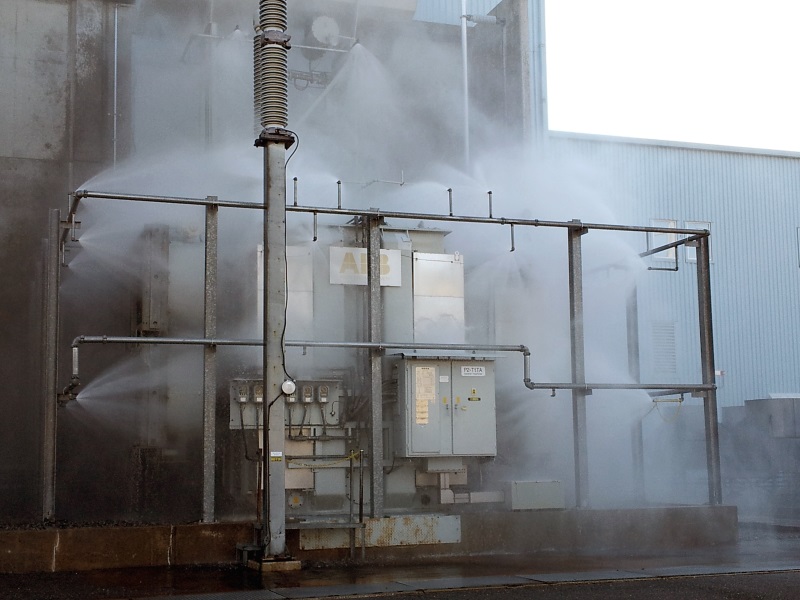
Scope of use of water fire extinguishing
Once again, attention should be focused on the complete safety and effectiveness of water fire extinguishing SNIP. First of all, this concerns the absence of a threat to the health of people evacuated from the danger zone. That is why this type of fire extinguishing is suitable for:
- urban, cultural and entertainment centers;
- social infrastructure institutions, which include clinics, schools or kindergartens;
- airports and railway waiting pavilions;
- office buildings;
- large indoor sports facilities;
- warehouse facilities of any size, covered parking lots or repair hangars;
- underground and detached parking lots for residential buildings.
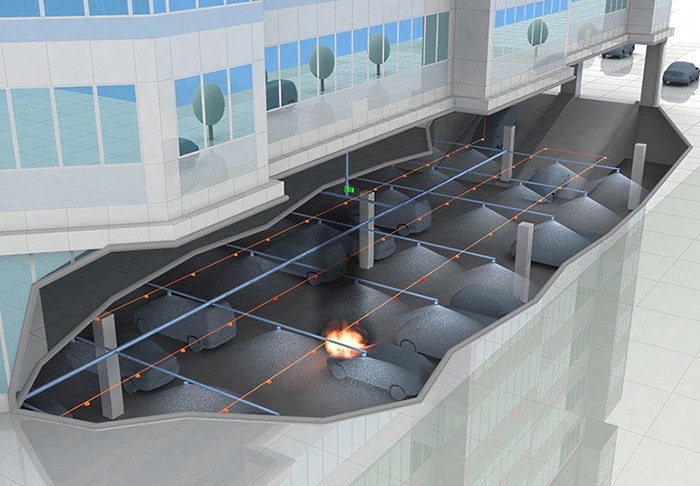
Safety is a job for professionals!
According to statistics, more than 80% of our company's clients prefer our proposal for the implementation of water fire extinguishing, the project of which we develop individually. If you need to secure the controlled object as reliably as possible from negative impact fire and at the same time incur minimum costs on the purchase of the system, then this offer will be most relevant.
In addition to water systems, we are engaged in design and installation:
- gas fire extinguishing systems (ideal for maintaining the integrity and operability of high-tech equipment that has entered the fire site);
- foam fire extinguishing systems (for extinguishing class A and B fires);
- powder fire extinguishing systems (for extinguishing class A, B, C, D fires).
We draw your attention to the fact that the work of such a plan should definitely be given into the hands of professionals. The safety of your material and technical values, as well as people's lives, will directly depend on the quality of the installed equipment and the level of competence of installation manipulations. Based on the experience of our company, you can be guaranteed to eliminate the risks of defects. In addition, our water fire extinguishing, the price of which is kept by our company in a zone that is comfortable for the customer and, as a rule, is more attractive than that of competitors, will allow you to make the right, reasonable choice.
SPRINKLER fire extinguishing system. Principle of operation
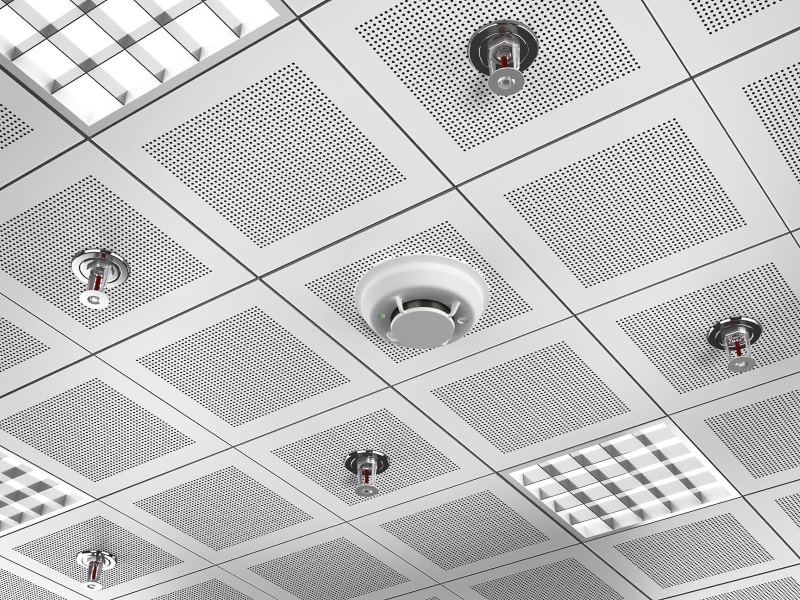
Our company is widely practicing the installation of two types of water systems automatic fire extinguishing... The first of these is SPRINKLER installations. Their main advantage is activation only in the local area where the temperature threshold was exceeded. In line with modern, technical requirements to the main pipeline section (to the transport zone). Directly the sections of pipes that transport water to the structure of the sprayers fire extinguishing agent are not filled. Thanks to this solution, it becomes possible to implement the project of a SPRINKLER installation of water fire extinguishing in rooms where there is a low temperature regime. In practice, this means leveling the risks of false alarms of the system, and, as a consequence, preserving the existing material and technical values. SPRINKLER , the cost of which will not become critical for your budget, this is undoubtedly one of the best options protecting your facility.
DENCHERNAYA fire extinguishing system. Principle of operation
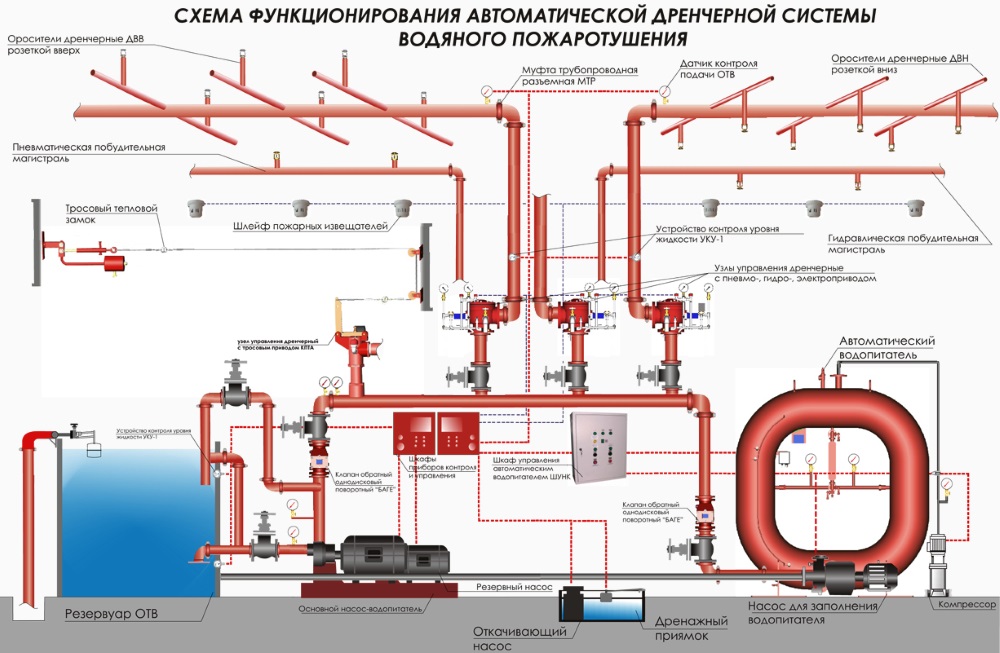
The second water fire extinguishing system is Drenchernaya. Unlike SPRINKLERNOY, it does not have a so-called thermal lock. As a result, the system is activated in absolutely all controlled areas. The undoubted advantages of such a system:
- quick response to a fire that has arisen and its elimination;
- detection of fire at the earliest stage of its occurrence.
In general, SPRINKLER and DANCHER fire extinguishing systems are effective way to localize the source of fire at a controlled facility.
Technical work regulations
To date, the technical regulations GOST R5068-94 are relevant. It regulates design work, installation work, test launch and commissioning of automatic fire extinguishing installations into the active phase. Also, the technical instructions "SP 5.13130.2009" apply. This documentation strictly defines the design parameters for water fire extinguishing systems:
- the actual consumption of the substance intended for extinguishing fires;
- the power of irrigation of the source of fire and the time interval of impact on it;
- the values of the area of the area for which the individual sprayer is responsible;
- the distance between the seats of the nozzles of the system.
In addition, the performer is required to know the basic indicators:
- designs of all types of spray;
- localization and area of the entire serviced area;
- actual capacities of installed pumping units;
- type of valves;
- capacity of containers for the used fire extinguishing agent.
Trust your safety in reliable and professional hands!
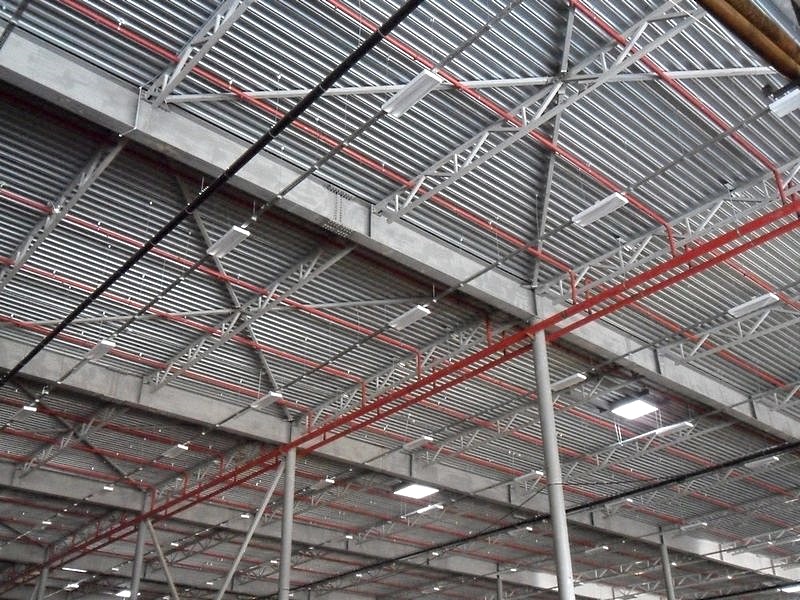
Head of installers of Magmatika LLC - Melnikov Vladmimr Nikolaevich:
“I work in construction after college, I went through all the stages - I was an electrician of a security and fire alarm system, an electrician, a foreman, a head of a section. I love my work and feel responsible for each installer and for each device and sensor "
A water and foam fire extinguishing system is the most commonly used method of extinguishing a fire. Such a system can be used in any room, it is very easy to use and affordable. The water extinguishing device requires low cost water to extinguish fires over a large area. The water fire extinguishing system is subdivided into:
Sprinkler- a network of pipelines, constantly filled with water, on which sprinklers (sprinklers) are located. The sprinkler is equipped with an easily melting nozzle, which melts when a fire appears and the temperature rises and opens the flow of water. Such a system creates a water cloud, which significantly reduces water costs and reduces damage to the structure.
Deluge- the valves of such a system are always open, and water is supplied to them by a signal from the fire alarm system. Such a fire extinguishing system is suitable for creating a water curtain to prevent the spread of the ignition.
Water fire extinguishing installations cool burning structures up to the right temperature, and, therefore, the termination chemical reaction burning.
Water fire extinguishing system - from 300,000 rubles
Automatic water fire extinguishing is one of the safest methods of extinguishing fires and spreading fire in rooms where there are a large number of people. The water used to extinguish a fire is absolutely safe and harmless to human health and life.
The cost of a water fire extinguishing system depends on the size and type of facilities. Our employees will do everything necessary calculations and make a detailed estimate for you.
Purpose of the water fire extinguishing system
Powder fire extinguishing systems are used to implement fire protection various designs, buildings and objects with a large area. Sprinkler fire extinguishing installations are used at such facilities as:
Residential buildings
Hotels
Deluge fire extinguishing systems are used to ensure safety:
Manufacturing enterprises
Office buildings
Storage and hangars
Low temperature rooms
Advantages and disadvantages of a water fire extinguishing system
| Installation of water fire extinguishing has a number of advantages, namely: Fast reaction in case of fire Effective and reliable fire suppression Profitability Availability and low cost Convenience and ease of use Long distance water supply |
Despite the large number of advantages of such a system, it has some limitations:
It is forbidden to extinguish electrical equipment with water, because water is electrically conductive Potential infliction of large damage to property and premises by an extensive flood of water Lack of applicability automatic installation water fire extinguishing in rooms containing items of historical and cultural value |
Calculation, design, installation and installation of water and foam fire extinguishing systems
![]() The Alliance Monitoring company provides high-quality and professional services for the creation of a project, as well as maintenance, installation and assembly of water and foam fire extinguishing installations. In our company, you can order the creation and installation of the system you need at a low price. We use only proven systems and structures and reliable materials, thanks to which we can guarantee long-term and high-quality operation of any fire-fighting system.
The Alliance Monitoring company provides high-quality and professional services for the creation of a project, as well as maintenance, installation and assembly of water and foam fire extinguishing installations. In our company, you can order the creation and installation of the system you need at a low price. We use only proven systems and structures and reliable materials, thanks to which we can guarantee long-term and high-quality operation of any fire-fighting system.
We provide our customers with an accurate and detailed calculation of the installation or Maintenance any system, and you can purchase a water fire extinguishing device, as well as the services you need at a favorable and optimal price in our company.
Normative documents regulating the installation and use of water fire extinguishing systems
1. Sprinkler installations for water and foam fire extinguishing, depending on the air temperature in the premises, should be designed:
water-filled - for rooms with a minimum air temperature of 5 ° C and above;
air - for unheated rooms with a minimum temperature below 5 ° C.
2. Sprinkler installations should be designed for rooms with a height of not more than 20 m, with the exception of installations designed to protect structural elements coatings of buildings and structures. In the latter case, the parameters of installations for rooms with a height of more than 20 m should be taken according to the 1st group of rooms (see Table 1.1.5).
3. For one section of a sprinkler installation, no more than 800 sprinkler sprinklers of all types should be accepted. In this case, the total capacity of the pipelines of each section air installations should be no more than 3 m 3.
4. When using a control unit with an accelerator or exhauster, the capacity of pipelines of air installations can be increased to 4 m 3.
5. Each section of the sprinkler installation must have an independent control unit.
6. When protecting several rooms or floors of a building with one sprinkler section, it is allowed to install liquid flow alarms on supply pipelines, excluding ring ones, to issue a signal specifying the ignition address, as well as to activate warning and smoke removal systems.
7. Sprinkler sprinklers for water-filled AUP are installed vertically with rosettes up or down or horizontally, in air AUP - vertically with rosettes up or horizontally.
8. Installation of sprinkler sprinklers should be done in such a way that the sprayed or sprayed stream of water from the fired sprinkler does not directly affect the adjacent sprinklers.
9. Within the same protected area, sprinklers of the same type with the same outlet diameter should be installed.
10. The distance between sprinkler sprinklers and walls (partitions) with a class fire hazard Kl should not exceed half the distance between the sprinkler heads indicated in table. 1.1.2.
11. The distance between sprinkler sprinklers and walls (partitions) with non-standardized fire hazard class should not exceed 1.2 m.
12. The distance between sprinkler heads of water fire extinguishing installations installed under smooth ceilings (coatings) must be at least 1.5 m.
13. It is allowed to connect fire hydrants of the internal fire-fighting water supply system to the supply pipelines of water-filled sprinkler AUP with a diameter of 65 mm and more.
14. The operating time of internal fire hydrants equipped with manual water or foam fire nozzles and connected to the supply pipelines of the sprinkler installation should be taken equal to the operating time of the sprinkler installation.
15. The design of internal fire hydrants should be carried out in accordance with SNiP 2.04.01-85 *.
Main sources used: NPB 88-2001, GOST R 50680, GOST R 50800
1. Automatic switching on of deluge installations should be carried out by signals from one of the types technical means:
Incentive systems;
Fire alarm installations;
Technological equipment sensors.
2. The incentive pipeline of deluge installations filled with water or a solution of a foaming agent should be installed at a height relative to the valve, not exceeding 1/4 of the constant pressure level in the supply pipeline, or in accordance with the technical documentation for the signal valve used in the control unit.
3. For several functionally connected deluge curtains, it is allowed to provide one control unit.
4. The inclusion of deluge curtains is allowed either automatically when the fire extinguishing installation is triggered, or manually (remotely or locally).
5. The distance between the sprinklers of deluge curtains should be determined on the basis of ensuring the flow rate of water or foaming agent solution of 1 l / s per 1 m of the opening width. When installing deluge curtains in two or more lines located at a distance of no more than 0.5 m from each other, the total water consumption should be at least 1 l / s per 1 m of the curtain with a duration of at least 1 hour.
6. The distance from the thermal lock of the incentive system to the floor plane (covering) should be from 0.08 to 0.40 m.
7. To increase the speed of the deluge AUP and reduce the degree of corrosion internal surfaces supply and distribution pipelines are allowed to be filled with water to the level of the lowest located deluge sprinkler. If the sprinklers have easily disposable plugs or caps, it is allowed to fill the supply and distribution pipelines with water completely; at the same time, to remove air in the most high point of the pipeline system, it is necessary to install a valve with an outlet diameter of no more than 10 mm.
Scheme of working with us
To order high-quality and professional service, installation and installation of a water fire extinguishing system at an attractive price in the Alliance Monitoring company, you must:
Call us at the phone number indicated on the website
Alliance Monitoring will analyze your facility
We will prepare a detailed calculation of the cost of the services you need and form an offer
Per shortest time we will carry out the execution of all necessary work on fire-fighting your object
After the completion of all work, we will hand over the finished object and provide the accompanying documentation
Benefits of working with us
The Alliance Monitoring company provides only first-class services for fire-fighting work and the installation of any fire suppression systems. When ordering the design and installation of a water fire extinguishing system in Alliance Monitoring, you get:
Licensed, professional and fast provision of all services at an attractive price
Certified materials with quality components
Guaranteed fire prevention in case of fire
We guarantee high quality, as well as long-term and reliable operation of the powder fire extinguishing system of our company, thanks to which you can ensure safety for your facility and employees.






